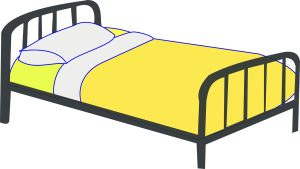
SICKLE CELL AND 6 TYPES OF CRISES
Image by Clker-Free-Vector-Images from Pixabay
Did you know that there are six different types of crises that people with Sickle cell have to endure? The most common is vaso-occlusive but let us look through them all in detail:-
Vaso-occlusive crisis – most common; is a painful sickle cell crisis (or vaso-occlusive crises) is the commonest manifestation of SCD and is characterized by recurrent episodes of acute, severe pain from tissue ischemia as a result of vasco-occlusion. Sickle cell anemia patients often experience episodes of acute pain that are caused by vaso-occlusive crisis (VOC).
Hemoglobin is a protein inside red blood cells and is responsible for transporting oxygen. Hemoglobin S molecules tend to stick together and form aggregates. These aggregates distort the shape of red blood cells, resulting in so-called sickle-shaped red blood cells. Hemoglobin S also damages the membrane of red blood cells, which makes them sticky. As a result, the cells tend to adhere to the inner lining of blood vessels. Sickle red blood cells also are stiffer than normal blood cells. The combination of these two characteristics is thought to promote the blockage of small blood vessels, which prevents oxygen supple to tissues and causes injury.
Patients with Sickle cell anemia may experience VOC several times per year. Pain is unpredictable and frequently occur spontaneously but may be seen after infection, exposure to cold, dehydration or in uncommon situations after emotional stress, exercise or alcohol, often no precipitation cause can be found, as triggers of VOC are not entirely understood. VOC crisis is responsible for around 90% of hospital admission and visits in patients with SCD. Legs, arms, back, chest and abdomen are often involved in VOC. VOC might cause leg ulcers, stroke, kidney insufficiency and spontaneous abortion.
Acute splenic sequestration (ASS) – Splenic sequestration is the enlargement of the spleen that can be life-threatening. There are 2 types of splenic sequestration in Sickle cell disease (acute and chronic). Chronic splenic sequestration may not cause problems and the doctor may choose to record the size of the spleen at each visit to make sure it is not getting any larger. ASS can happen when sickled red blood cells get trapped in the spleen, causing the spleen to enlarge.
Sickle cell disease affects the red blood cells causing them to sickle or become banana-shaped. The main purpose of red blood cells (RBCs) is to deliver oxygen to the body. Sickled RBCs stick together and slow the flow of oxygen to the tissues. When sickled RBCs are trapped in the spleen, the rest of the body does not get enough oxygen. If not treated, ASS, can cause the body to go into shock.
What then is the spleen? The spleen is an oval-shaped organ located on the left side of the body. It is protected by the ribcage. The spleen has 2 functions: it helps the body fight infection and it helps to crat and filter blood cells.
The immediate treatment is red blood cell transfusion as this provides the body with much needed oxygen to the cells and releases the sickled RBCs trapped in the spleen. The spleen reduces in size and the anemia is corrected.
The chances of having another episode of ASS are high. If the first episode was severed or if a second ASS occurs, the doctor may recommend splenectomy (removal of the spleen). A person can live without a spleen because other organs in the body perform the same function as the spleen. So, a person can have a healthy life without the spleen.
Infarctive crisis – Infarction (obstruction of the blood supply to an organ) of the bone marrow leads to release of inflammatory meditators which activate afferent nerve fibers resulting in severe generalized bone pain. Almost any bone may be involved and there is a tendency for the infarcts to become infected. Sometimes infection may occur.
Aplastic crisis (AC) is when the body does not make enough new Red Blood Cells to replace the ones that are already in the blood. Normally, the soft tissue at the centre of your bones, called bone marrow, constantly make new RBCs. These cells go into your blood supply and carry oxygen through the body. If you have SCD, your body needs to make a lot of new RBCs but during AC, the bone marrow stops making RBCs for a short time. This is called transient (temporary) AC. It normally lasts for 7-10 days; after which the bone marrow starts making RBCs again.
AC is usually caused by a virus. Parvovirus B19 is one of the most common causes. The virus causes the bone marrow to stop making a new RBCs for 7-10 days. An AC is not a problem for most people, because normal RBCs last 90-120 days but it is a serious problem in people with SCD. Their RBCs only last 7-20 days and if the sickled cells stops making RBCs for a few days, they can get severed anemia.
Haemolytic crisis (HC) is an acute drop in hemoglobin level marks this crisis. It is common in patients with co-existent G6PD deficiency. HC is the rupturing of RBCs and the release of their contents into surround fluid (e.g. blood plasma). One cause of hemolysis is the action of hemolysins, toxins that are produced by certain pathogenic bacteria or fungi. Another cause is intense physical exercise. Hemolysins damage the RBCs. HC are acute accelerated drops in hemoglobin level. The RBCs break down at a faster rate.
Bone crisis is caused by bone marrow ischemia or infarction. These crises usually start after age 2-3 years and occur as gnawing, progressive pain, most commonly in the humerus, tibia, and femur and less commonly in the facial bones. Periarticular pain and joint effusion, often associated with a sickle cell crisis, are considered a result of ischemia and infarction of the synovium and adjacent bone and bone marrow. Patients with acute bone pain crisis usually present with fever, leukocytosis, and warmth and tenderness around the affected joints. This process tends to affect the knees and elbows, mimicking rheumatic fever and septic arthritis. Bone involvement is the commonest clinical manifestation of sickle cell disease both in the acute setting such as painful vaso-occlusive crises, and as a source of chronic, progressive disability such as avascular necrosis and the long-term effects of sickle cell disease on bone mineral density, growth and chronic bone and joint damage.
Orthopedic complications of sickle cell disease (SCD) include vaso-occlusive bone pain, osteonecrosis, and infections (osteomyelitis and septic arthritis). Individuals with SCD are functionally asplenic and are at risk for infections that may be life-threatening, and other bone and joint complications can cause severe pain and immobility that significantly interfere with functioning and quality of life.
References: www.medscape.com; www.ncbi.com; www.gpnotebook.co.uk; www.stjude.org; www.uptodate.com and www.sicklecellanemianew.com
My book – HOW TO LIVE WITH SICKLE CELL: Sickle Cell and I (is now available on OkadaBooks and Amazon). Pls get your copy.








You are a great blessing! I have sickle cell. I will be 49 on March 8
Hi Kennedy, thanks for getting in touch. Praise God! You will celebrate your birthday in divine health and you will live long. Bless you
My brother has Sickle Cell and he will be 41 this August. Keep doing what you do and may God bless you immensely with long life and good health.
Hello Solomon,
Thank you so much for reaching out and your prayers. May God grant you and your brother long life too. Stay safe.
Thank you for SICKLE CELL AND 6 TYPES OF CRISES , is verry informative.
ONE Hidden Ingredient Lowers Cholesterol Level Below 100 And Clears Out 93%,
here: http://bit.ly/drop-your-cholesterol-to-a-healthy-level
Try it, will help!!! 🙂
Hello Allen,
Thanks for your kind words and the recommendations. Take care!
I’m glad I found a http://www.howtolivewithsicklecell.co.uk, a
quality webpage!
Many people are struggling with high blood pressure, this can help: https://s96.me/blood-pressure
Good wishes and health to all! 🙂
Hello Yoko,
Do keep reading the blog and sharing with others. Wishing you well.